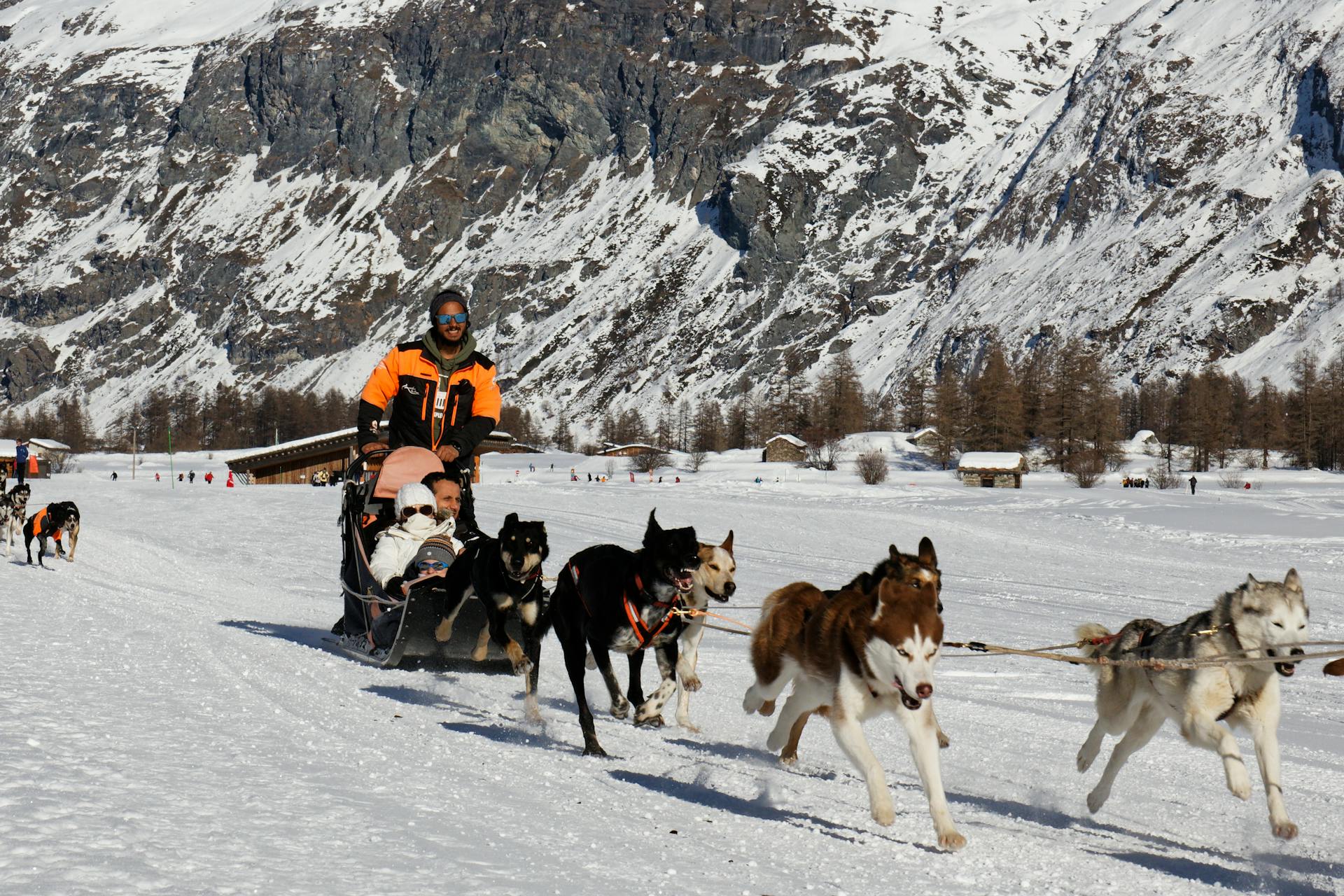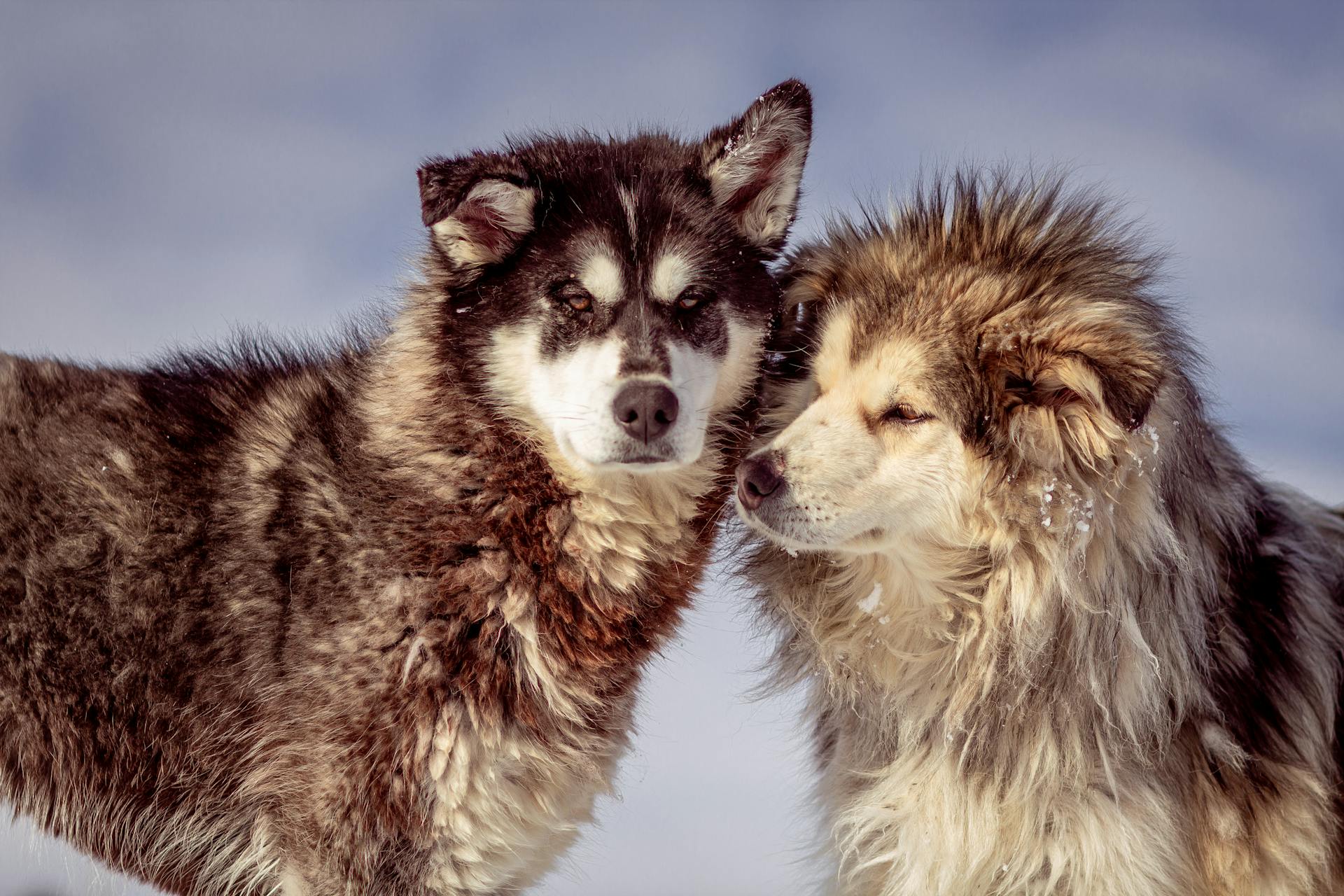
Arctic Huskies are naturally athletic and agile dogs, bred to withstand the harsh Arctic climate. They're built for endurance, with a strong body and a thick coat that helps them thrive in freezing temperatures.
Their ancestors, the Chukchi people's sled dogs, were a key part of their survival in the Arctic. These dogs were essential for transporting goods and hunting for food.
Arctic Huskies are highly intelligent and independent dogs, which can sometimes make them challenging to train. They require consistent, patient training and plenty of exercise to keep them happy and healthy.
They're also highly social dogs that thrive on interaction with their human family members.
Explore further: Arctic Husky
Physical Characteristics
Siberian Huskies are known for their striking appearance, and their coat is one of their most distinctive features. It's thicker than most other breeds, comprising two layers: a dense undercoat and a longer topcoat of short, straight guard hairs.
Their coat protects them effectively against harsh Arctic winters, but it also reflects heat in the summer. It can withstand temperatures as low as −50 to −60 °C (−58 to −76 °F).
Siberian Huskies come in a variety of colors and patterns, usually with white paws and legs, facial markings, and a tail tip. The most common coats are black and white, then less common copper-red and white, grey and white, pure white, and the rare “agouti” coat.
Discover more: Images of White Siberian Huskies
Traits and Characteristics
Siberian Huskies are known for their striking appearance, with erect triangular ears and a thick double coat in various colors.
Their eyes can be blue, brown, green, or amber, and some Huskies even have heterochromia, where each eye is a different color.
Huskies are highly energetic and love to run, making them great jogging companions.
Male Huskies typically weigh between 45-60 pounds and stand between 21-24 inches tall, while females weigh between 35-50 pounds and stand between 18-20 inches tall.
Their coats shed heavily, especially during seasonal changes, so regular grooming is essential to manage shedding and maintain the health of their coat.
Siberian Huskies are highly social and quick to make friends with complete strangers, but they can also be independent and stubborn at times.
Here are some key traits of a Siberian Husky:
Their almond-shaped eyes come in shades of blue, brown, or a combination of both, and are one of their most striking features.
Siberian Huskies are generally loyal and do well with other canine companions, but they can be prone to escaping if not properly trained or supervised.
Nose
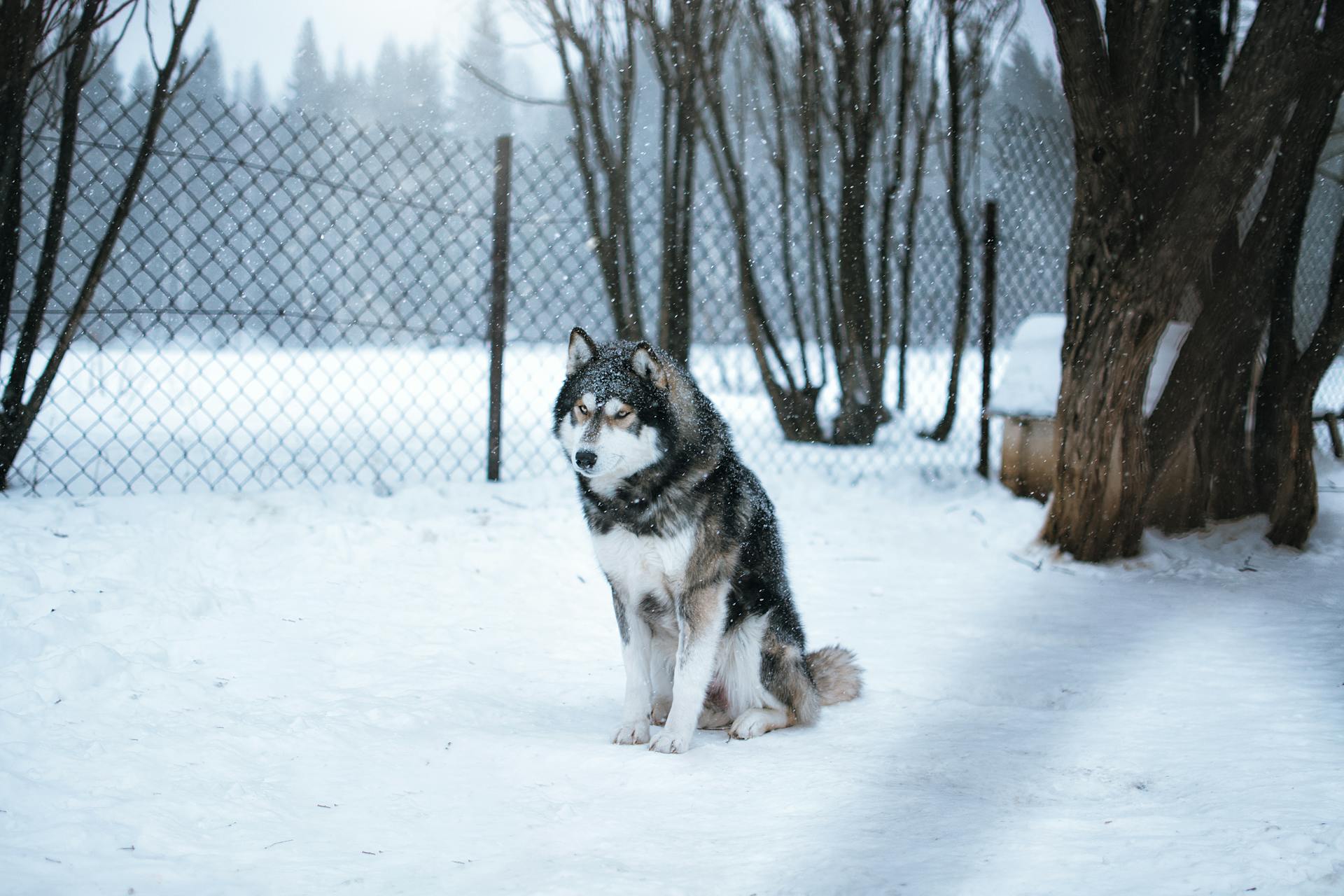
The nose of a Siberian Husky is quite unique. It's preferred to be neither pointed nor square in show-quality dogs.
The color of the nose depends on the dog's coat color, with gray dogs having a black nose, black dogs having a tan nose, and copper-colored dogs having a liver nose.
In some cases, Huskies can develop "snow nose" or "winter nose", a condition known as hypopigmentation in animals. This is acceptable in the show ring.
Discover more: Black Alaskan Husky
Coat Types and Colors
Siberian Huskies have a thick coat that's perfect for withstanding harsh Arctic winters, but it also reflects heat in the summer. Their coat is made up of two layers: a dense undercoat and a longer topcoat of short, straight guard hairs.
Their thick coats require weekly grooming to prevent matting and tangling. In fact, you can expect lots of hair and lots of shedding, especially during spring and fall when they blow their coats.
Here's an interesting read: Husky Blowing Coat
The most common coat colors are black and white, followed by copper-red and white, grey and white, pure white, and the rare "agouti" coat. Some Huskies also have blondish or piebald spotting.
Here are the most common coat colors and patterns found in Siberian Huskies:
- Black and white
- Copper-red and white
- Grey and white
- Pure white
- Agouti
- Blondish or piebald spotting
Their striking masks, spectacles, and other facial markings can add to their unique appearance.
Behavior
Arctic Huskies are known to howl rather than bark, which can be a distinctive and attention-grabbing trait.
They have a strong prey drive, which means they can be prone to chasing small animals like cats, birds, and squirrels. With proper training, they can learn to coexist with other pets.
Siberian Huskies are notorious escape artists, and they can dig under, chew through, or even jump over fences to get out. A 6 ft fence is recommended to prevent them from escaping.
Their independent nature can sometimes lead to mischievous behavior, such as digging and burying things. They love to explore and can be destructive if left alone for long periods.
To establish a strong bond with your Arctic Husky, it's essential to provide them with frequent companionship and exercise. A 15-minute daily obedience training class can help with this.
They are highly social dogs and thrive on interaction with their owners and other dogs. Early socialization is crucial to ensure they grow into well-rounded dogs.
Here are some key things to keep in mind when it comes to the behavior of Arctic Huskies:
- They are best suited for owners with active lifestyles who can provide regular exercise and attention.
- They are not ideal for first-time owners or those who will leave them alone for long periods.
- They can be destructive if bored or not given adequate exercise.
- They have a strong instinct to dig and bury things, and teaching them to dig in a specific spot can be helpful.
- They are not overly suspicious of strangers, including burglars, and may not make ideal watchdogs.
History and Lineage
The Siberian Husky's history is deeply rooted in the harsh, frozen landscapes of Siberia and Alaska. The breed originated among the Chukchi, a tribe of Siberian nomads, who used the dogs as fast transportation and family companions.
In 1908, Siberian Huskies were imported to Alaska and used as sled dogs during the gold rush, where they quickly gained popularity in Alaskan sled racing. Their endurance and cold tolerance made them ideal for this purpose.
The Siberian Husky's genetic makeup is closely tied to the gray wolf, but they also show a genetic closeness to the now-extinct Taymyr wolf of North Asia due to admixture. This admixture is believed to have provided early dogs living in high latitudes with beneficial phenotypic variation.
Take a look at this: Alaskan Husky Sled
The breed's ancestry is a mix of Siberian and European breeds, with the Siberian Husky and the Malamute sharing a close genetic relationship with each other and the Chukotka sled dogs from Siberia. This genetic connection is a testament to the breed's origins in the region.
In 1925, a relay of dog teams, including Siberian Huskies, brought life-saving serum to the isolated town of Nome, Alaska, during a diphtheria outbreak. This heroic endeavor earned national prominence for the drivers and their dogs.
Care and Maintenance
Siberian Huskies need regular exercise to stay happy and healthy, with a daily dose of 30 to 60 minutes of physical activity. This can be achieved through jogging, hiking, or other outdoor sports.
To keep your Husky's coat in top condition, brush them 2 or 3 times a week to remove shed or loose hair. This will also help during moulting season when they tend to shed a lot.
A Husky's double coat requires regular care, and they tend to shed heavily during spring and autumn. To minimize this, commit to brushing their coat at least once a week during the year, and daily during shedding season.
Here's a quick rundown of Husky grooming essentials:
- Brushing: 2-3 times a week, daily during shedding season
- Nail trimming: every 1-2 months
- Dental care: brush teeth at least 2-3 times a week
- Ear care: clean the outer ear, not the ear canal
By following these simple care and maintenance tips, you'll be well on your way to keeping your Siberian Husky happy, healthy, and looking their best.
Care
Grooming your Siberian Husky is a must to keep them looking and feeling their best. Regular brushing is essential to prevent matting and tangling, especially during shedding season.
You should brush your Husky's coat at least once a week, but ideally daily during shedding season. This will help remove loose hair and prevent it from getting all over your furniture.
Daily brushing is also crucial for preventing gum disease and bad breath. Brush your Husky's teeth at least two or three times a week, and daily if possible. This will help remove tartar buildup and bacteria that can cause problems.
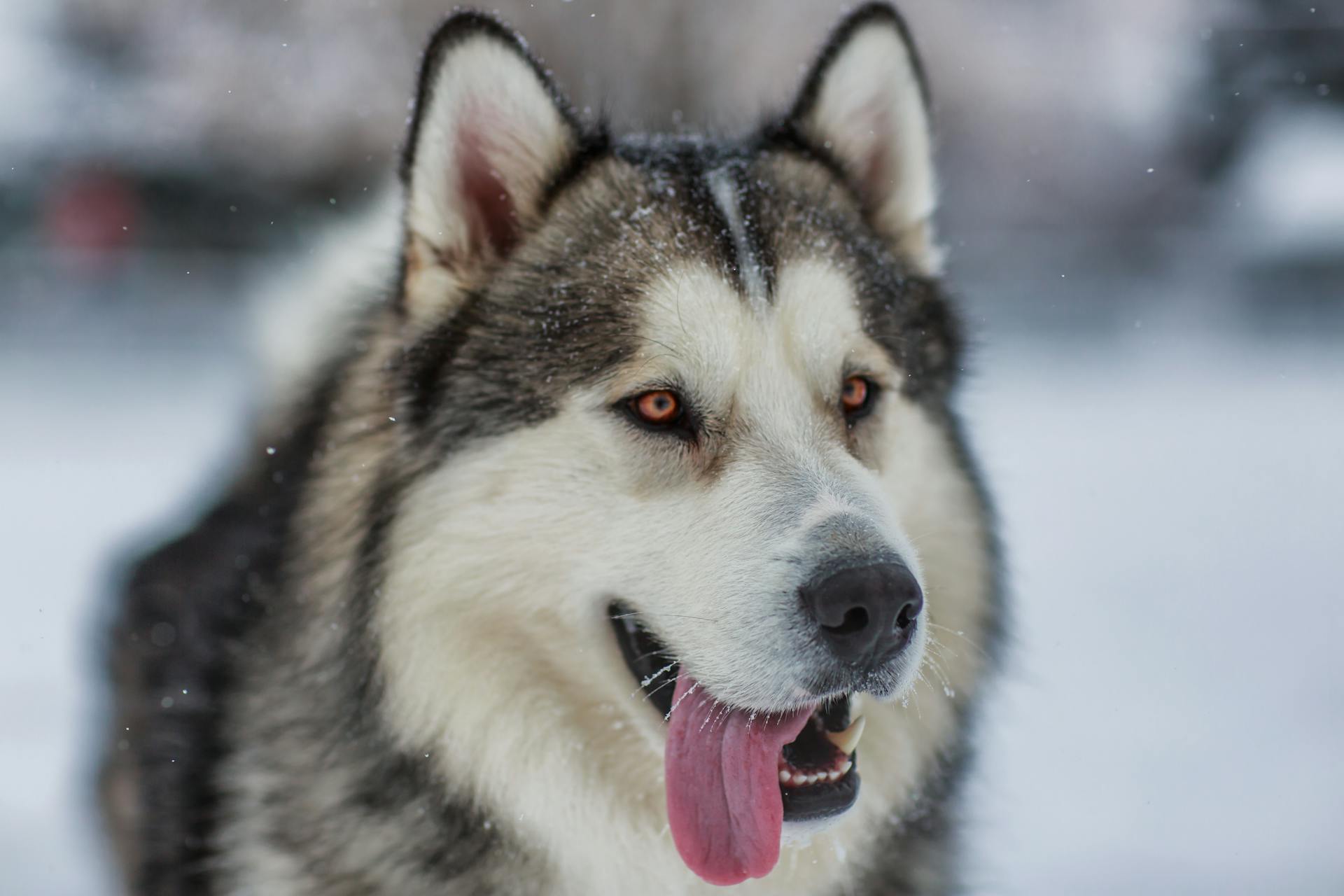
Trimming your Husky's nails is also important. If you can hear them clicking on the floor, they're too long. Trim them once or twice a month to prevent painful tears and other problems.
In addition to grooming, regular ear cleaning is a must. Just clean the outer ear, and avoid inserting anything into the ear canal. This will help prevent infections and keep your Husky's ears healthy.
Here's a quick rundown of the importance of regular grooming:
Overall, grooming your Siberian Husky is a crucial part of their care and maintenance. By following these simple tips, you can help keep them looking and feeling their best.
Nutrition
Nutrition is a crucial aspect of caring for your Siberian Husky. A Husky's diet should be tailored to their high energy needs, requiring around 1,000 calories per day, split over two meals.
Be mindful of the ingredients in your dog food, as some Huskies can have trouble digesting cereals like wheat.
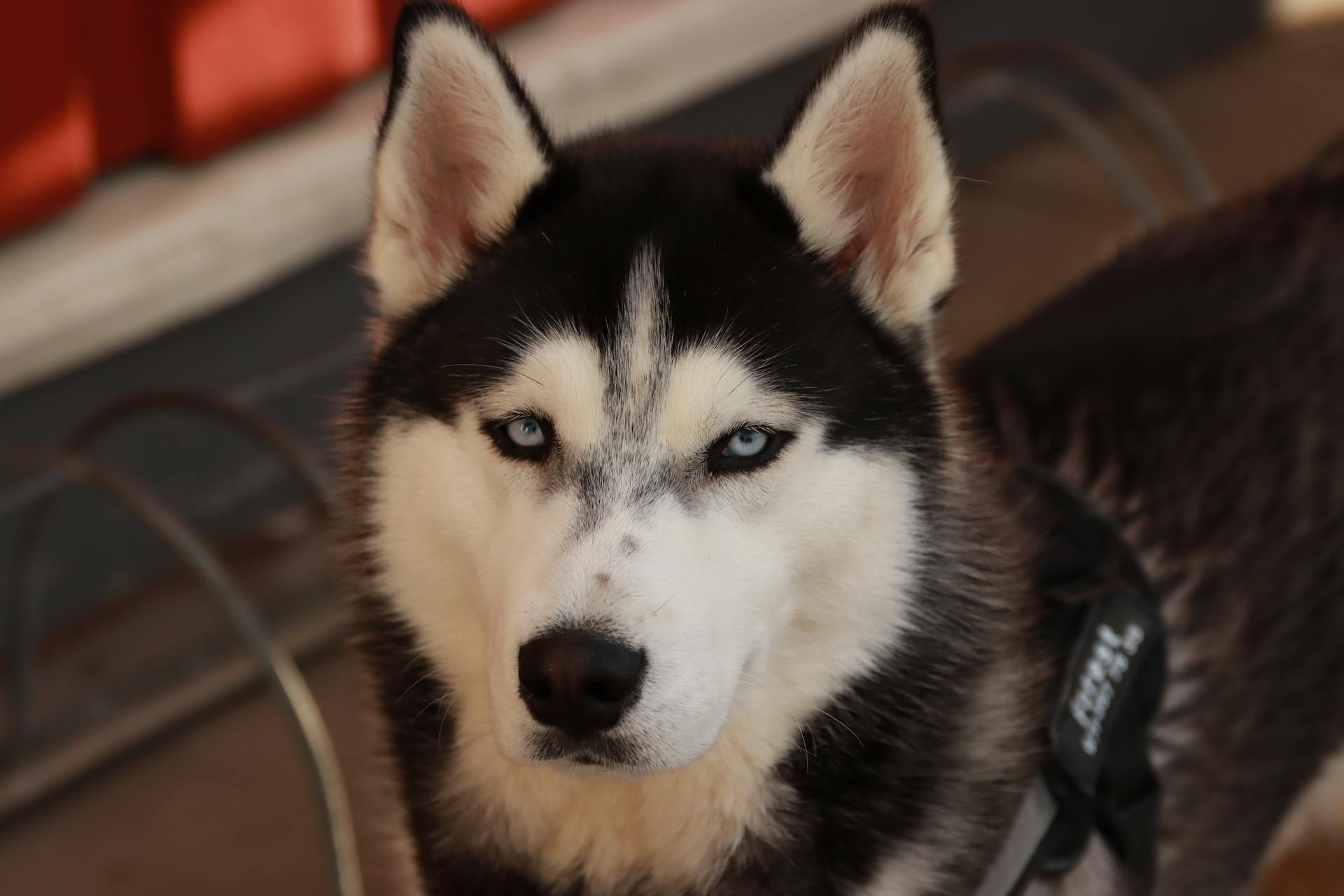
Regular exercise is essential for Huskies, as it helps burn off energy and stimulates their appetite. A slow metabolism means they need to move to stay healthy.
Their thick fur can make them prone to overheating, especially in summer months. Ensure your dog always has access to fresh water to avoid dehydration.
Here's a rough guide to help you estimate your Husky's daily food intake:
Health
Huskies are generally healthy dogs, but like all breeds, they can be prone to certain health issues. Cataracts are a common problem that can cause difficulty seeing due to an opacity in the lens of the eye.
Cataracts usually occur in old age, but in some cases, they can be surgically removed to improve the dog's vision.
Corneal Dystrophy is another condition that affects the eyeball's cornea, causing an opacity due to a collection of lipids. It's usually seen in young adults and affects more females.
There is no therapy for Corneal Dystrophy, but it doesn't seem to affect the dog's vision.
Progressive Retinal Atrophy (PRA) is a degenerative eye disorder that eventually causes blindness due to the loss of photoreceptors at the back of the eye. Fortunately, dogs can use their other senses to compensate for blindness.
Reputable breeders have their dogs' eyes certified annually by a veterinary ophthalmologist and don't breed dogs with this disease.
Here are some common health issues to be aware of in Huskies:
- Cataracts: an opacity in the lens of the eye that causes difficulty seeing
- Corneal Dystrophy: an opacity in the cornea caused by a collection of lipids
- Progressive Retinal Atrophy (PRA): a degenerative eye disorder that eventually causes blindness
To stay prepared for any health issues that may arise, consider getting a pet insurance plan to help cover your dog's veterinary needs.
Living with an Arctic Husky
Living with an Arctic Husky can be a thrilling experience, but it's essential to be aware of their exercise needs. They require a minimum of two hours of exercise per day, which can include brisk walks, runs, hikes, and games of fetch.
Their high energy levels also make them excel in agility sports. A bored Husky is likely to go looking for their own entertainment, which can lead to problems.
You'll need to provide plenty of physical and mental stimulation to keep them happy and engaged. This includes puzzle toys to help beat boredom and prevent destructive behavior.
Children and Pets
Living with an Arctic Husky is a wonderful experience, but it's essential to consider the needs of both your child and your furry friend.
Huskies can be very tolerant of children, but it's crucial to supervise interactions between dogs and young children to prevent biting or ear or tail pulling.
Supervising is key, so make sure to teach your child how to approach and touch dogs gently.
Teach your child never to approach any dog while it's eating or try to take the dog's food away.
Socialization classes are a must for Husky puppies, as they help them get used to other dogs and people.
Recommended read: Husky Dog Training
Huskies are naturally very affectionate to strangers, but socialization teaches them how to behave and greet other dogs and their owners.
Keep in mind that Huskies have a strong prey drive, so if you have other pets like cats or small animals, it's essential to supervise their interactions closely.
Some Huskies thrive in multi-pet households, especially when they're raised with other pets from puppyhood.
Living with a
Living with an Arctic Husky means having a furry friend that's always on the go. They need plenty of room to run and play, so a spacious home with a fenced-in yard is a must.
Arctic Huskies need at least two hours of exercise a day, which can be achieved through brisk walks, runs, hikes, and games of fetch. They also excel in agility sports.
A bored Husky is likely to get into trouble, so mental stimulation is crucial. Puzzle toys can help keep them engaged and prevent destructive behavior.
For another approach, see: Arctic Alaskan Malamute
Dog hair is a given with an Arctic Husky - they have a thick double coat that sheds frequently. Weekly brushings are a must, and a good vacuum and lint roller will be your best friends.
Arctic Huskies are also very vocal, known to "sing" or howl quite frequently. If noise is a problem, this breed might not be the best fit.
What to Know Before Buying or Rehoming a Dog
If you're thinking of bringing an Arctic Husky into your family, there are a few crucial things to consider.
Huskies are good-natured and people-loving, but they do require a lot of attention and exercise. They need at least 2 hours of active exercise every day, making them best suited to dog owners with active lifestyles and plenty of time.
A strong independent streak and tendency for mischief means training must start early, be consistent, and find the right balance between firm and fair.
Huskies have a high prey drive, so it's essential to keep them on a lead during walks to prevent them from chasing small animals.
If you do decide to bring a Husky into your family, make sure to assess the temperament of the parents and what breeding lines they are from. For example, a puppy bred from showing stock might be calmer and easier to manage than one descended from working dogs.
To ensure your Husky stays safe and secure, any outdoor space must be escape-proof, with sturdy fences and secure gates.
Here are some key things to consider before bringing a Husky into your home:
Frequently Asked Questions
What are 5 interesting facts about Huskies?
Here are 5 interesting facts about Huskies: They originated in Siberia, are high-energy companions, have thick fur for cold climates, come in a variety of eye colors, and are known for their unique and playful personalities.
How smart is a Siberian Husky?
Siberian Huskies have an average intelligence ranking of 74 out of 138 dog breeds, indicating they may need more repetitions to learn new commands. With consistent training, they can achieve a 50% or better success rate in obeying commands.
How far can a husky hear?
A husky's hearing range can reach up to half a mile or more, allowing them to detect sounds from a significant distance. This exceptional hearing ability makes sound a primary means of canine communication.
What makes a Husky so special?
The Husky is special due to its ancient origins and impressive physical abilities, making it a loyal and affectionate companion. Its unique combination of strength, speed, and stamina has earned it a place as one of the world's oldest and most beloved dog breeds.
Are Huskies waterproof?
Huskies and similar breeds have a special fur coating that repels water, but they're not completely waterproof - their undercoat can still get wet if exposed to prolonged water exposure. Their unique fur helps protect them from water, but it's not a guarantee against getting wet.
Featured Images: pexels.com
